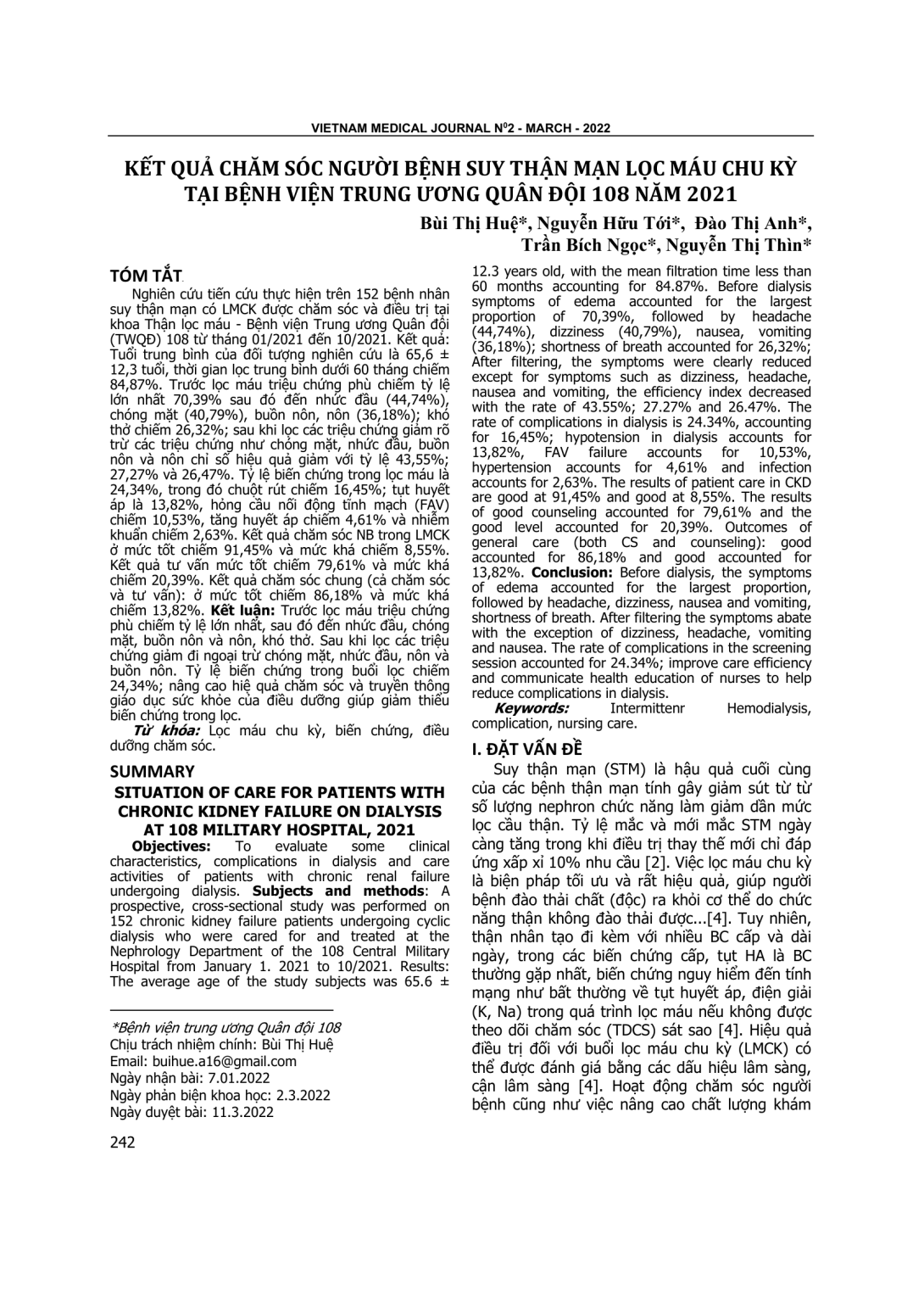
Nghiên cứu tiến cứu thực hiện trên 152 bệnh nhân suy thận mạn có LMCK được chăm sóc và điều trị tại khoa Thận lọc máu - Bệnh viện Trung ương Quân đội (TWQĐ) 108 từ tháng 01/2021 đến 10/2021. Kết quả: Tuổi trung bình của đối tượng nghiên cứu là 65,6 ± 12,3 tuổi, thời gian lọc trung bình dưới 60 tháng chiếm 84,87%. Trước lọc máu triệu chứng phù chiếm tỷ lệ lớn nhất 70,39% sau đó đến nhức đầu (44,74%), chóng mặt (40,79%), buồn nôn, nôn (36,18%); khó thở chiếm 26,32%; sau khi lọc các triệu chứng giảm rõ trừ các triệu chứng như chóng mặt, nhức đầu, buồn nôn và nôn chỉ số hiệu quả giảm với tỷ lệ 43,55%; 27,27% và 26,47%. Tỷ lệ biến chứng trong lọc máu là 24,34%, trong đó chuột rút chiếm 16,45%; tụt huyết áp là 13,82%, hỏng cầu nối động tĩnh mạch (FAV) chiếm 10,53%, tăng huyết áp chiếm 4,61% và nhiễm khuẩn chiếm 2,63%. Kết quả chăm sóc NB trong LMCK ở mức tốt chiếm 91,45% và mức khá chiếm 8,55%. Kết quả tư vấn mức tốt chiếm 79,61% và mức khá chiếm 20,39%. Kết quả chăm sóc chung (cả chăm sóc và tư vấn): ở mức tốt chiếm 86,18% và mức khá chiếm 13,82%. Kết luận: Trước lọc máu triệu chứng phù chiếm tỷ lệ lớn nhất, sau đó đến nhức đầu, chóng mặt, buồn nôn và nôn, khó thở. Sau khi lọc các triệu chứng giảm đi ngoại trừ chóng mặt, nhức đầu, nôn và buồn nôn. Tỷ lệ biến chứng trong buổi lọc chiếm 24,34%; nâng cao hiệ quả chăm sóc và truyền thông giáo dục sức khỏe của điều dưỡng giúp giảm thiểu biến chứng trong lọc.
To evaluate some clinical characteristics, complications in dialysis and care activities of patients with chronic renal failure undergoing dialysis. Subjects and methods: A prospective, cross-sectional study was performed on 152 chronic kidney failure patients undergoing cyclic dialysis who were cared for and treated at the Nephrology Department of the 108 Central Military Hospital from January 1. 2021 to 10/2021. Results: The average age of the study subjects was 65.6 ± 12.3 years old, with the mean filtration time less than 60 months accounting for 84.87%. Before dialysis symptoms of edema accounted for the largest proportion of 70,39%, followed by headache (44,74%), dizziness (40,79%), nausea, vomiting (36,18%); shortness of breath accounted for 26,32%; After filtering, the symptoms were clearly reduced except for symptoms such as dizziness, headache, nausea and vomiting, the efficiency index decreased with the rate of 43.55%; 27.27% and 26.47%. The rate of complications in dialysis is 24.34%, accounting for 16,45%; hypotension in dialysis accounts for 13,82%, FAV failure accounts for 10,53%, hypertension accounts for 4,61% and infection accounts for 2,63%. The results of patient care in CKD are good at 91,45% and good at 8,55%. The results of good counseling accounted for 79,61% and the good level accounted for 20,39%. Outcomes of general care (both CS and counseling): good accounted for 86,18% and good accounted for 13,82%. Conclusion: Before dialysis, the symptoms of edema accounted for the largest proportion, followed by headache, dizziness, nausea and vomiting, shortness of breath. After filtering the symptoms abate with the exception of dizziness, headache, vomiting and nausea. The rate of complications in the screening session accounted for 24.34%; improve care efficiency and communicate health education of nurses to help reduce complications in dialysis.
- Đăng nhập để gửi ý kiến
